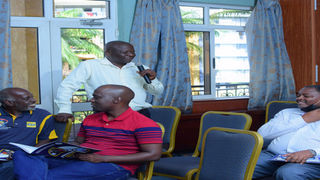
A section of the NACOBA members at the Annual General Meeting.
Prosper
Prime
How Namilyango College Sacco has amassed Shs2 billion
What you need to know:
- The eight-year old Namilyango College Old Boys Association Sacco encourages members to save as low as Shs15,000 on a weekly basis.
- The Sacco started in 2012 with 15 members; the 10 were active while the five kept on the sidelines waiting to see how things go. For two years, only Shs5m was saved until the first official meeting at Fairway Hotel where the extra gear was ignited with the election of the first of the Executive Committee under Mr Ronald Kasozi.
It is a cold Saturday morning and the south wing of City Royal Resort Hotel, Bugolobi is buzzing with excitement. A group of gentlemen is taking their seats for the annual general meeting of the Namilyango College Old Boys Association ( NACOBA) Savings and Credit Co-operative Society and there is reason to celebrate, the 10 year old sacco has hit a milestone of amassing Shs2.272b in savings.
“ The NACOBA annual general meeting held on November 6, 2011 under the outgoing leadership of Counsel Matthias Nalyanya, a committee headed by Vincent Salam was set up to propose an income-generating project for NACOBA that would make the Association self-sustaining and rid it of donor fatigue,” recalls Andrew Bazanye, a member of the sacco.
A year later on March 24, 2012 when Namilyango College was celebrating 110 years of existence, the sacco was officially launched. The core members who spearheaded the initiative included Andrew Lugalambi, Eng. Ronald Kato Kayizzi, Dr Isaac Kajja, Francis Sembuya and Michael Kyompitira Sebalu.

Saul Abok who is the secretary of the Namilyango College Old Boys Association sacco.
Since inception, the lot has grown to 405 members. Micheal Watmon Kinyera was the first chief executive officer whose first task was collecting 30 signatures - the number required to get one running. It officially registered on October 10, 2013 with the first member being Dr. Arthur Kwizera.
The current sacco chairman Edward Mpalanyi recalls hosting investment and sacco guru, Dunstan Kisuule, CEO of Y-Save, who shared an inspiring insight on running a sacco when he was invited in late December.
“He gave an amazing presentation on cooperatives . It went beyond the Sacco and opened our eyes to the other possibilities and options. The story of 15 people (10 members and 5 on the fence) at KPC in 2000, growing to a membership of more than 700, with current monthly inflows of between Shs300m and Shs600m, and an asset base worth Shs10 billion at cost was simply inspiring,” says Mpalanyi.
“All this in addition to the real estate investments and successful business enterprises established. Governance questions were answered, but there was a lot for us to learn. He offered to help work closely with our executive to give guidance and support wherever needed. From that day, the NACOBA Sacco never looked back. It has continued growing in membership, savings, capital and assets,” added Mpalanyi.
But what drove this Sacco?
“Apart from building a self-sustained organisation, the old boys were to get loans at friendly interest rates to grow themselves. The idea was and still is to start from tier 1 as a savings and credit society with the aim of growing into a Microfinance Deposit taking Institution (MDI) and ultimately into a bank – NACOBANK,” says the current CEO Victor Bwanika.
The Sacco idea started in 2012 with 15 members; the 10 were active while the five kept on the sidelines waiting to see how things go. For two years, only Shs5M was saved until the first official meeting at Fairway Hotel where the extra gear was ignited with the election of the first of the Executive Committee under Mr Ronald Kasozi. The Sacco has since grown its membership to 500 with a total savings portfolio of Shs2.272b and a total asset base of Shs2.763b.
Contributions
The Sacco membership is diverse and the Old Boys are spread all over the continent.
“The members are required to save a monthly minimum of Shs100,000 and on average, we collect Shs100m in savings every month,” explains Bwanika.
Explaining what motivates members to save, Bwanika says, “Despite the fact that our growth vision of becoming an MDI and then a bank is made known to our members when joining the SACCO, we have a weekly savings drive named the NACOSAVE. This is themed “Save a beer, Drive Safely to NACOBANK.”
Here, members get to save as low as Shs15,000 on a weekly basis. Members even often set bet-targets of raising a particular sum in a given timeline. It is fun seeing members save towards a common financial goal,”says Bwanika.
The Sacco also makes an effort towards giving members a commendable return on their savings. For the last three years, the return on members’ savings has averaged 10 percent per annum. This has motivated many to keep saving with the SACCO and buy more shares.
Investment options
Members’ funds are invested in three different ways. About 70 percent in loans to members (primary investment), 10 percent in unit trusts (mandatory cash reserve) and 20 percent in other investments such as land and for resale to members.
When it comes to loans, there is a credit committee that guides the executive committee and management. For other investments, there is an investment committee that scouts and presents safe, secure and profitable investment opportunities to the Executive committee for review and consideration. The Sacco also lends money to only members.
Profit sharing
After taking off the statutory deductions and total dividends payable, whatever that remains of the net surplus is given back to members as an interest return on their savings depending on their monthly savings. The members are then free to liquidate the return or reinvest it.
Medical Insurance
“The health of our members is our first priority. The Sacco through her partnership with Prudential Assurance Uganda Limited offers group annual medical insurance services to its members and their families at friendly premiums,” says Bwanika. Every Lenten Period, the Sacco collects alms from its members and buys relief items for the less advantaged children in care homes.




